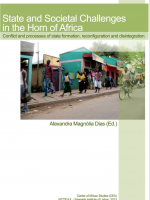Publicaciones

The Security Issues behind the Ethiopian Intervention in Somalia (2006-2009)
Tipo de publicación: Capítulo de Libro
Editorial / Institución editora: Center of African Studies (CEA) ISCTE-IUL, Universidad de Lisboa, 2013.
Abstract:
The relations between Ethiopia and Somalia have known turbulent episodes in recent history. The deployment of Ethiopian troops in Somalia in 2006 can be understood as a new phase in their relations, but one with historical roots. It implied a change from the relative peace between the two countries since the end of the Cold War and the start of a conflict dissimilar to previous wars between the two states. It is widely acknowledged that Ethiopian troops have regularly crossed the frontier during peacetime to police the border area, especially to fight armed movements and to secure the Ethiopian state. But this was not something overtly admitted by the Ethiopian government in 2006, until Meles Zenawi openly deployed his troops in Somalia with the tacit support of the international community. Since then, their presence has been virtually constant, though two phases can be discerned: from December 2006 to January 2009, and from November 2011 until the present.
This chapter will focus on the securitization process in Ethiopia that permitted the deployment of Ethiopian troops in Somalia between 2006 and 2009, in an attempt to go beyond the traditional understanding of security, with its focus on the military sector and its problem-solving approach. The chapter is not so much about the war as on the securitizing speech acts on the threat posed by the Union of Islamic Courts (UIC), the securitization of this issue, the political context in which it happened and some of its consequences for Ethiopia. In this regard, this work is partly inspired by Didier Bigo’s question related to the task of critical security studies: “Who is doing an (in)securitization move, under what conditions, towards whom, and with what consequences?” (Bigo, 2008: 125). This research draws on critical security studies and international political sociology and following Paul Williams attempts to bring them closer to the English School by analysing the implications of this intervention for the international society. (Williams, 2005) It argues that the Ethiopian intervention has to be understood as the product of a securitization move, and in consequence that it needs to be approached beyond its bilateral manifestation, taking account of a broader context, as much in time as in space.
The argument is divided into three parts. Firstly, I briefly outline the Ethiopian intervention in 2006-2009, and propose new insights to broaden and deepen our understanding of it following the work done by Critical Security Studies. My suggestion is that the analysis of the discourse around the intervention, as reflected in The Ethiopian Herald (TEH) — the main official English language newspaper in Ethiopia —, imply that the securitization move of the Ethiopian government regarding the events in Somalia in 2006 and after, helped not only to secure the Ethiopian state but also to reshape the image of the Ethiopian regime and its political project. Secondly, to understand this move it is necessary to enlarge the picture in order to situate this process in a wider context. Questioning the meaning of this intervention as a bilateral issue, I connect it to the local and international context: the aftermath of the Ethiopian elections, and the securitization of Africa, in order to understand the connections of different political agendas. Finally, I briefly consider the consequences of this intervention for Ethiopia and the international society, concluding that the securitization process helped to (re)create the government’s local and international authority and legitimacy or at least to reshape the idea of it.
GONZÁLEZ-AIMÉ, Elsa, «The Security Issues behind the Ethiopian Intervention in Somalia (2006-2009)» en DIAS, Alexandra M. (ed.) State and Societal Challenges in the Horn of Africa: Conflict and processes of state formation, Centro de Estudios Africanos (CEA) ISCTE-IUL, Lisboa, 2013, ps. 32-47.
